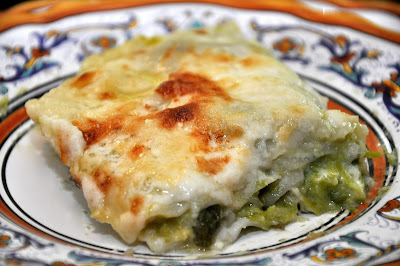A good dish of lasagna is one of the most satisfying meals I can imagine. But, to be honest, a dish of classic lasagne alla bolognese can be a bit on the heavy side, especially as the weather gets warmer. That's the beauty of vegetarian lasagne; if not exactly dietetic, they are lighter than meat-based lasagne and yet totally satisfying. You can make lasagne with almost any vegetable, but perhaps my favorite is made with asparagus, the most elegant and, to my taste, most toothsome of Spring vegetables.
The basic technique is just the same as for lasagne alla bolognese (see this post for the recipe): begin by preparing a batch of fresh pasta, then a good portion of béchamel sauce. But instead of the ragù, you prepare a bunch of asparagus two ways: Take a bunch of asparagus, trim and peel them, then boil, or better, steam them in lightly salted water until tender—not crisp tender or mushy, but fully tender. Cut off the tips and set them aside, and purée the remaining stems in a blender or food processor with a bit of béchamel sauce. Season the purée with salt to taste—it should be quite savory.
Now assemble your lasagna just as you would classic lasagne: place a layer of pasta in a buttered baking dish, then a thin layer of béchamel, followed by a layer of asparagus purée, then place a few asparagus tips here and there, then sprinkle generously with grated parmesan cheese.
Keep on layering in this way until you have used up your ingredients—or until you have laid down four or five layers of pasta. (This kind of lasagna should not be too thick.) Cover with a layer of béchamel, sprinkle with more grated parmesan and dot with butter.
Bake in a hot oven (400F/200C) for about 20 minutes or so, until the top is lightly browned. Allow the dish to settle and cool for 10-15 minutes or more—see below—before serving.
NOTES: The basic technique for this vegetable lasagna is really quite easy once you get the hang of making the béchamel and fresh pasta. And it can almost be an every-day dish if you use store-bought fresh pasta, although, as I've commented before, finding true fresh egg pasta suitable for this kind of lasagna can be a challenge. If you use no-boil lasagna sheets, make sure to make a rather loose béchamel and slather it abundantly over the pasta, as unboiled pasta absorbs a lot of sauce. I've hit upon another substitution that, however unorthodox, I like better: egg roll wrappers. Yes, egg roll wrappers. While they lack the rich egg flavor of homemade pasta, they have the same fine, silky texture as very fine homemade egg pasta. And you add them directly to the baking dish, no pre-boiling necessary, saving considerable time and effort.
If you want a richer dish, you can sauté the asparagus tips in butter before adding them to the dish. And you can also make the dish even more savory if you like by allowing the asparagus purée to insaporire in a soffritto of butter and shallots before folding in a bit of béchamel. In the alternative, instead of asparagus purée, you can sauté both tips and stems in butter, along with a bit of shallot, and layer them over the béchamel. And some versions of this dish really go to town, adding bits of soft cheese like a fontina or bel paese, and/or shredded prosciutto along with the asparagus tips.
You can make all sorts of vegetable lasagne using the same basic method. For vegetables (like mushrooms) that don't purée too well, you can simply slice them thinly and sauté them in butter or oil, along with a bit of shallot or onion or garlic (depending on the vegetable and the effect you are after). If fact, almost any sauteed contorno can do service to stuff lasagne in this way: funghi trifolati, piselli alla romana... You can even make lasagna with a combination of different vegetables, with each layer of pasta dressed with a different vegetable. There is really no end to the variations you can dream up. And with all that lovely bechamel and butter, they are all delicious!
It is very important to let the dish rest for some time before serving. Not only is the pasta scalding hot when it has just come out of the oven, but as the dish cools it also firms up a bit. If you serve lasagne direct from the oven, it will fall apart when you serve it. And the longer you wait, the firmer the dish will be. A 10-15 minute wait is the minimum, but you can let it rest for up to 30 minutes. And don't worry, it will still be nice and warm.
It is very important to let the dish rest for some time before serving. Not only is the pasta scalding hot when it has just come out of the oven, but as the dish cools it also firms up a bit. If you serve lasagne direct from the oven, it will fall apart when you serve it. And the longer you wait, the firmer the dish will be. A 10-15 minute wait is the minimum, but you can let it rest for up to 30 minutes. And don't worry, it will still be nice and warm.
Nota bene: More tips on lasagna-making are included in the post on lasagne alla bolognese.
